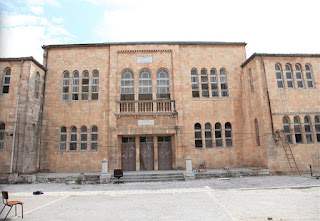Historic Etz Chaim Yeshiva Building to be Preserved and Updated into the Surrounding Machne Yehuda Area
Pei, Cobb, Freed and Partners, the firm tasked with projects like the Grand Louvre and the US Holocaust Museum, are now planning on preserving and updating the Etz Chaim Yeshiva complex. Situated next door to Machane Yehuda, the firm is sensitive to the needs and history of the location.
About the Historic Early 20th Century Etz Chaim Yeshiva
ישיבת עץ החיים
הישיבה היתה ברחוב יפו 115 והיום, תוך פעילות שימור, האזור הופך לחלק מהשוק.
הישיבה נוסדה בעיר העתיקה בשנת 1841 על ידי הרב שמואל סלנט. משנות ה – 50 של המאה ה – 19 שכנה הישיבה בחצר ה"חורבה" שבמרכז הרובע היהודי. בישיבה היו 13 כיתות (רמות לימוד) כאשר המעבר מרמה לרמה היתה תלויה ביכולתו של התלמיד ולא בהכרח בגילו. הילדים נכנסו לישיבה בגיל צעיר מאד ולמדו בה עד לנישואיהם.
עם זקנותו מינה הרב שמואל סלנט את בעלה של נכדתו – הרב יחיאל מיכל טוקצ'ינסקי למנהל הישיבה והוא זה שיזם את הקמת הסניף ברחוב יפו . אז הוקם במקום גם "כולל" שהוא ישיבה עבור התלמידים שנישאו.
שני אישים מפורסמים מאד כיהנו בישיבה והם: הרב איסר זלמן מלצר שעמד בראש הישיבה החל [English text follows] משנת 1925 והרב אריה לוין שכיהן כמשגיח
שני אישים מפורסמים מאד כיהנו בישיבה והם: הרב איסר זלמן מלצר שעמד בראש הישיבה החל [English text follows] משנת 1925 והרב אריה לוין שכיהן כמשגיח
בשנת 1910 נפתח הסניף של הישיבה ברחוב יפו כאשר היה שם בית ישן, אליו נכנסה הישיבה. כדי להגדיל את הכנסות הישיבה נבנו חנויות להשכרה על גבול השוק ובקצה המגרש של הישיבה ברחוב יפו. בשנת 1934 הוקם מבנה נוסף מפואר בין הבניין הישן ורחוב יפו ובשנת 1936 יצאה הישיבה מהעיר העתיקה ומרכזה היה בסניף של רחוב יפו. בשיא גדלה הגיעה הישיבה ל – 13 סניפים שהיו פזורים ברחבי העיר.
במסגרת עבודות הקמת הרכבת הקלה הוסרו החנויות של רחוב יפו ונשארה רק החזית שלהן.
בשנת 2010 עזבה הישיבה את המתחם ברחוב יפו והמקום מיועד למתחם חנויות, משרדים ומגורים. הישיבה עתידה לעבור למתחם בית הספר למל ברחוב ישעיהו.
"ישיבת עץ חיים" נמצאת באתר "אהבת ירושלים" במסגרת - "סיור ברחוב יפו (4)"
WIKIPEDIA: Etz Chaim Yeshiva was originally a Talmud Torah that was established in 1841 by the Chief Rabbi of Jerusalem, Shmuel Salant. For the first two years classes were held in various rooms throughout the Old City.
In 1857, the yeshiva consolidated into a group of buildings adjacent to the Hurva Synagogue, sharing the premises with the Beth Din of Jerusalem. It was at this stage that the institution was renamed "Etz Chaim Yeshiva." The first permanent home of the yeshiva was financed by Rabbi Tzvi Zeev Fiszbejn (Fishbein in English), a wealthy brush maker originally from Miedzyrzec Podlaski in what is today Poland, who donated a thousand rubles in silver to Rabbi Salant for that purpose in 1863.
The head teacher was Rabbi Chaim Mann. His brother Yehuda Leib Mann was the secretary who also served as a teacher. They were the sons of Rabbi Yaakov Mann, who was a prominent scholar who had declined the invitation of Rabbi Tzvi Pesach Frank to become a dayan on the Beth Din. (He went on to build the Sha'arey Tzedek Medical Center and the Lemel school). As the yeshiva expanded, a plot of land on Jaffa Road was acquired in 1908, and subsequently a kollel was established catering mainly for the alumni of the yeshiva. At the time Rabbi Yechiel Michel Tukichinsky, who was married to the granddaughter of Rabbi Salant, served as the rosh yeshiva.
After disputes arose between the pupils and the faculty, a permanent agreement was reached by Rabbi Tzvi Pesach Frank, who reallocated the positions of authority.
In 1925, Rabbi Isser Zalman Meltzer was appointed to lead the yeshiva and Rabbi Aryeh Levin was made the mashgiach. After the death of Rabbi Meltzer, his son-in-law, Rabbi Aharon Kotler, was appointed rosh yeshiva. In an unusual arrangement, he held this position while continuing to live in the United States, and visited Jerusalem on occasion. During the periods when he resided in Israel he delivered fortnightly lectures. After his death, Rabbi Elazar Shach was chosen to head the yeshiva and he also delivered fortnightly lectures. Some time later, Rabbi Yisroel Yaakov Fisher took up a position at the yeshiva. A grandson of Rabbi Aharon Kotler, Rabbi Zvulun Schwartzman, has served as one of the primary leaders.
A grandson of Rabbi Salant, Rabbi Nissan Tukichinsky, the son of Rabbi Yechiel Michel Tukichinsky, serves as head and director of the institution. For many years he traveled to the United States and South Africa to raise money to keep the institution functioning.
–––––––––––––––––––––––––––––––––
Although the yeshiva building on Jaffa Road is registered on Jerusalem's List of Protected Monuments, in 2007 the building was under the threat of demolition to make way for shops and offices. The authorities accepted an appeal for the buildings’ preservation. [Etz Chaim Yeshiva Building Saved from Destruction. Following the dramatic decision to save vast Jerusalem Forest areas from the massive Safdie construction program, conservatives have now won another round, saving the 100-year-old Etz Chaim yeshiva. Article from January 2007.]





No comments:
Post a Comment